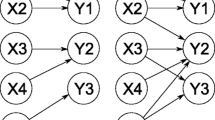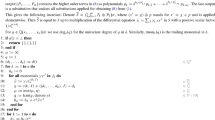Abstract
A growing understanding of complex processes in biology has led to large-scale mechanistic models of pharmacologically relevant processes. These models are increasingly used to study the response of the system to a given input or stimulus, e.g., after drug administration. Understanding the input–response relationship, however, is often a challenging task due to the complexity of the interactions between its constituents as well as the size of the models. An approach that quantifies the importance of the different constituents for a given input–output relationship and allows to reduce the dynamics to its essential features is therefore highly desirable. In this article, we present a novel state- and time-dependent quantity called the input–response index that quantifies the importance of state variables for a given input–response relationship at a particular time. It is based on the concept of time-bounded controllability and observability, and defined with respect to a reference dynamics. In application to the brown snake venom–fibrinogen (Fg) network, the input–response indices give insight into the coordinated action of specific coagulation factors and about those factors that contribute only little to the response. We demonstrate how the indices can be used to reduce large-scale models in a two-step procedure: (i) elimination of states whose dynamics have only minor impact on the input–response relationship, and (ii) proper lumping of the remaining (lower order) model. In application to the brown snake venom–fibrinogen network, this resulted in a reduction from 62 to 8 state variables in the first step, and a further reduction to 5 state variables in the second step. We further illustrate that the sequence, in which a recursive algorithm eliminates and/or lumps state variables, has an impact on the final reduced model. The input–response indices are particularly suited to determine an informed sequence, since they are based on the dynamics of the original system. In summary, the novel measure of importance provides a powerful tool for analysing the complex dynamics of large-scale systems and a means for very efficient model order reduction of nonlinear systems.










Similar content being viewed by others
Notes
References
Schoeberl B, Eichler-Jonsson C, Gilles ED, Muller G (2002) Computational modeling of the dynamics of the MAP kinase cascade activated by surface and internalized EGF receptors. Nat Biotechnol 20:370–375
Wajima T, Isbister G, Duffull SB (2009) A comprehensive model for the humoral coagulation network in humans. Clin. Pharmacol. Ther. 86:290–298
Kloft C, Trame MN, Ritter C (2016) Systems pharmacology in drug development and therapeutic use—a forthcoming paradigm shift. Eur J Pharm Sci 94:1–3
Antoulas A (2005) Approximation of large-scale dynamical systems. In: Advances in design and control. SIAM, Philadelphia
Okino MS, Mavrovouniotis ML (1998) Simplification of mathematical models of chemical reaction systems. Chem Rev 98(2):391–408
Rabitz H, Kramer M, Dacol D (1983) Sensitivity analysis in chemical kinetics. Annu Rev Phys Chem 34:419–461
Perumal TM, Gunawan R (2011) Understanding dynamics using sensitivity analysis: caveat and solution. BMC Syst Biol 5(1):41
Zi Z (2011) Sensitivity analysis approaches applied to systems biology models. IET Syst Biol 5(6):336–346
Lam SH, Goussis DA (1994) The CSP method for simplifying kinetics. Int J Chem Kinet 26:461–486
Zagaris A, Kaper HG, Kaper TJ (2004) Fast and slow dynamics for the computational singular perturbation method. Multiscale Model Simul 2(4):613–638
Dokoumetzidis A, Aarons L (2009) Proper lumping in systems biology models. IET Syst Biol 3(1):40–51
Brochot C, Tóth J, Bois FY (2005) Lumping in pharmacokinetics. J Pharmacokinet Pharmacodyn 32(5–6):719–736
Li G, Tomlin AS, Rabitz H, Tóth J (1994) A general analysis of approximate nonlinear lumping in chemical kinetics. I. Unconstrained lumping. J Chem Phys 101(2):1172–1187
Pilari S, Huisinga W (2010) Lumping of physiologically-based pharmacokinetic models and a mechanistic derivation of classical compartmental models. J Pharmacokinet Pharmacodyn 37(4):365–405
Snowden TJ, van der Graaf PH, Tindall MJ (2017) A combined model reduction algorithm for controlled biochemical systems. BMC Syst Biol 11(1):17
Lall S, Marsden JE, Glavaški S (1999) Empirical model reduction of controlled nonlinear systems. In: Proceedings of the IFAC world congress, p 473–478
Gulati A, Isbister GK, Duffull SB (2013) Effect of Australian elapid venoms on blood coagulation: Australian Snakebite Project (ASP-17). Toxicon 61:94–104
Gulati A, Isbister GK, Duffull SB (2014) Scale reduction of a systems coagulation model with an application to modeling pharmacokinetic–pharmacodynamic data. CPT Pharmacomet Syst Pharmacol 3(1):e90
Tanos P, Isbister G, Lalloo D, Kirkpatrick C, Duffull S (2008) A model for venom-induced consumptive coagulopathy in snake bite. Toxicon 52:769–780
Cawthern KM, van’t Veer C, Lock JB, DiLorenzo ME, Branda RF, Mann KG (1998) Blood coagulation in hemophilia A and hemophilia C. Blood 91(12):4581–4592
Dokoumetzidis A, Aarons L (2009) A method for robust model order reduction in pharmacokinetics. J Pharmacokinet Pharmacodyn 36(6):613–628
Acknowledgements
The authors would like to thank Niklas Hartung (Computational Physiology Group, Institute of Mathematics, University of Potsdam) for valuable discussions and comments on the manuscript.
Author information
Authors and Affiliations
Corresponding author
Appendices
Appendix 1: Differential equations for the elimination-reduced 8-state variable model of the snake venom system
The model equations for the elimination-reduced model are:
All parameter values can be found in [2, Suppl. Fig. 2] and [17, Tables 1, 2]. The variable \(x_{{\text {env}},{{\text{II}}}}\) is equal to the initial value of \({{\text{II}}}\, (x_{{{\text{II}}}}(0)\)). This holds for all environmental state variables. All initial conditions can be found in [2, Suppl. Fig. 3] (Figs. 11, 12, 13, 14, 15; Tables 3, 4, 5, 6).
Concentration–time profiles of all state variables predicted by the original model excluding those concentration–time profiles already given in Fig. 3b
Comparison of concentration–time profiles for dynamical state variables of the elimination-reduced model (given in Fig. 4) based on 62-state variable model (solid) and the elimination-reduced 8-state variable model (dashed). For AVenom and CVenom the dashed and solid line coincide
Comparison of fibrinogen concentration–time profile based on 62-state variable model (solid) and the model with knock-out of X and V (dot-dashed), knock-out of V (dashed) and knock-out of Pg, the inactive form of factor P (dotted). Note that the larger impact of a knock-out of V is due the fact that in this case, the impact of the activated form of factor X changes (due to the lacking complex formation of Xa and Va)
Appendix 2: Differential equations for the elimination-reduced 7-state variable model and 13-state variable model of the PT test
The model equations for the seven-state variable elimination-reduced model for the high TF are:
All parameter values and initial conditions for the state variables can be found in [2, Suppl. Figs. 2, 3]. The state variable \(x_{{\text {env}},{{\text{II}}}}\) is equal to the initial value of \({{\text{II}}}\, (x_{{{\text{II}}}}(0)\)). This holds for all environmental state variables.
The model equations for the 13-state variable elimination-reduced model for the low TF are:
All parameter values and initial conditions for the state variables can be found in [2, Suppl. Figs. 2, 3]. The state variable \(x_{{\text {env}},{{\text{II}}}}\) is equal to the initial value of \({{\text{II}}}\, (x_{{{\text{II}}}}(0)\)). This holds for all environmental state variables.
Rights and permissions
About this article
Cite this article
Knöchel, J., Kloft, C. & Huisinga, W. Understanding and reducing complex systems pharmacology models based on a novel input–response index. J Pharmacokinet Pharmacodyn 45, 139–157 (2018). https://doi.org/10.1007/s10928-017-9561-x
Received:
Accepted:
Published:
Issue Date:
DOI: https://doi.org/10.1007/s10928-017-9561-x









